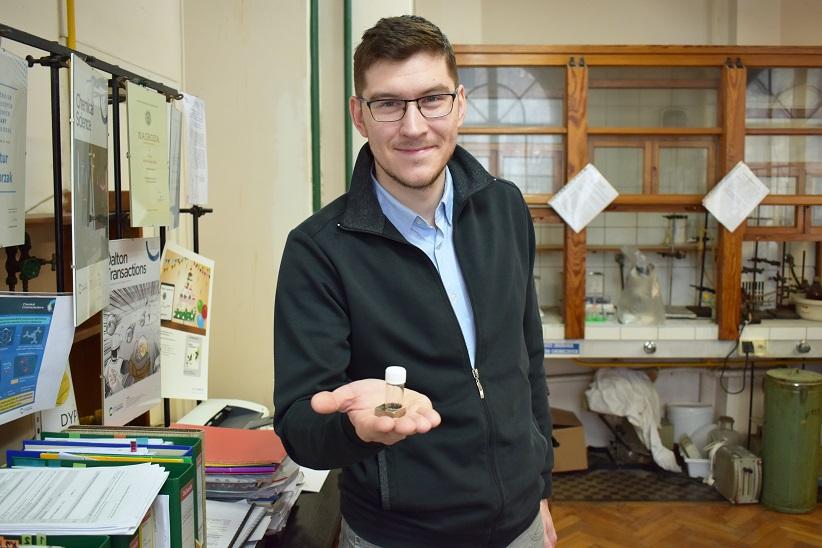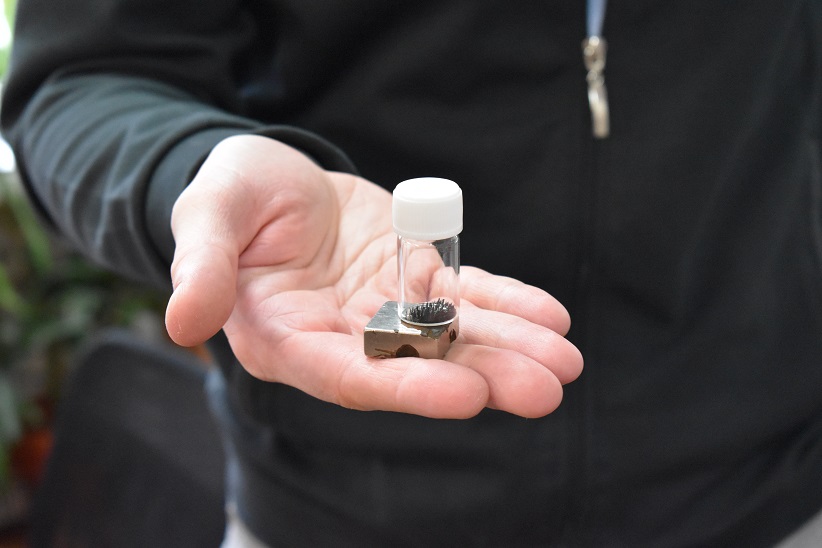An idea for effective removal of a radioactive element
Removal of radioactive caesium salts from aqueous solutions is crucial from the point of view of human health and natural environment protection. High concentrations of the 137Cs isotope have been found mainly in the post-disaster area of nuclear power plants, but the problem with the disposal of waste containing caesium applies to other areas of the world because caesium is produced in routine organic syntheses, for example, drug synthesis. Nanomaterials containing sumanene may prove to be a solution to these problems.
As for organic chemistry, sumanene is a new compound. It was discovered by Professor Hidehiro Sakurai from Osaka University in Japan in 2003. Research on this aromatic compound in the context of its application as a receptor for caesium cation is conducted at the Warsaw University of Technology by Dr Artur Kasprzak from the Faculty of Chemistry. The scientist commenced research on the practical application of sumanene as a selective receptor for caesium cations and is the only scientist in the world devising practical applications of sumanene in this respect.
“I got interested in sumanene in 2019 during my internship at Osaka University, while I was working in Professor Sakurai’s team,” says Dr Artur Kasprzak. “Research conducted as part of the grant Materials Technologies-3 is also carried out in collaboration with the Professor’s research team,” he explains.
During his internship in Japan, the PW researcher noticed that the majority of research conducted on sumanene was mainly structural and synthetic. It lacked information about the practical use of sumanene. He only managed to find a comment that sumanene interacted selectively with caesium cations.
Toxic but widely used
The 137Cs isotope is used in cancer treatment. As they increase the productivity of reaction, caesium fluoride and caesium carbonate are in turn used in routine chemical reactions in laboratories in the pharmaceutical industry, among others. In spite of being found toxic by the US Food and Drug Administration (FDA), caesium chloride is used in dietary supplements. One should also bear in mind the contamination of the natural environment by radioactive caesium during nuclear power plant disasters.
“Since Japan is an island, it suffered more serious problems in the Fukushima disaster than those in Chernobyl because toxic caesium was released into water, including groundwater and the area where rice is grown,” says Dr Kasprzak. “We should also bear in mind sea currents and the impact of this radioactive element on fish,” he adds.
Additionally, the 137Csisotope half-life, i.e. the time required for one-half of the atomic nuclei of the element to decay, is concerning. It amounts to 30 years, which means that once the element is released into the environment, it will remain there for a minimum of 30 consecutive years.
Caesium removal
Threats caesium waste poses for the natural environment and human life have inspired the development of materials dedicated to caesium salts removal from aqueous solutions. The research intensified after the disaster in the nuclear power plant in Japan in 2011. However, the problem with adsorbents devised so far is their low selectivity for caesium salts and removal of all cations (lack of selectivity), including the desired ones such as potassium and magnesium. Additionally, the disposal of caesium waste is highly costly.
A new functional material was created as part of Dr Kasprzak’s project, consisting of magnetic carbon nanoparticles with a cobalt core modified with sumanene.
The question that immediately comes to mind is: Why apply a material with magnetic properties if sumanene is so effective as a selective receptor for a molecular caesium cation?
“The caesium-absorbing material is added to the contaminated water,” says Dr Kasprzak. “Its magnetic properties facilitate quick, easy and precise separations of the material from the solution. If you put a material lacking these properties in contaminated water, you must separate it in another way, for instance, by draining. It might be easy in the kitchen but a bit awkward in the industry. Magnetic properties facilitate the entire process. As soon as you place a magnet on a vial, the material separates from the solution, including caesium,” he explains.
The process of nanoadsorbent separation from an aqueous solution.
In collaboration with the Japanese team, Dr Kasprzak conducted research confirming that the tested material removes caesium from the solution. Sodium and potassium, which are present in the environment, were used as interferents, i.e. cations interfering with caesium removal, to confirm its effectiveness. Both issues were confirmed.
“I conducted a synthesis of a precursor of a drug used in cancer treatment. Its synthesis consists of several stages and caesium salt is used in one of them. I checked whether while applying the produced material you can remove caesium from aqueous waste produced in the synthesis. I managed to confirm that caesium removal process was successful.”
The researcher also confirmed that the produced material may be used many times, has a large adsorptive capacity and can be easily regenerated. It is sufficient to remove caesium with a small amount of water, which is why the volume of aqueous waste containing caesium can be reduced and lower the cost of waste storage/disposal.
_
The “Magnetic nanoadsorbents comprising sumanene for the selective and effective removal of caesium salts from aqueous solutions or organic wastes” project is funded as part of the research grant of the Research Centre POB Materials Technologies of the Excellence Initiative – Research University programme implemented at the Warsaw University of Technology.



